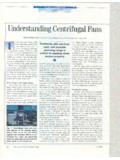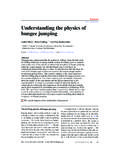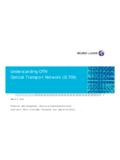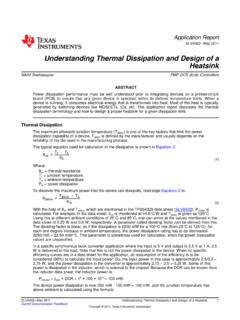Transcription of Understanding the Performance Implications of …
1 Understanding the Performance Implications of Buffer to Buffer Credit Starvation In a FICON Environment: Frame Pacing DelayPaper 7080 Steve GuendertPrincipal EngineerCMG 2007 International ConferenceDecember, 2007 Understanding the Performance Implications of Buffer to Buffer Credit Starvation: Frame Pacing 2007 CMG 2007 Steve Guendert 2007 Brocade Communications Systems, Inc. All rights reserved. 2 AbstractyThis paper will give a brief review on buffer-to-buffer credits (BB_credits) including current schema for allocating/assigning them. It will then discuss the one method currently available to detect BB_credit starvation on FICON directors, including a discussion on the concept of frame pacing delay. Finally, the author will outline a concept for a mechanism to count BB_creditusage. The paper will conclude with a discussion of another theoretical drawing board concept: dynamic allocation of BB_credits on an individual I/O basis similar to the new HyperPAVs concept for the Performance Implications of Buffer to Buffer Credit Starvation: Frame Pacing 2007 CMG 2007 Steve Guendert 2007 Brocade Communications Systems, Inc.
2 All rights reserved. 3 Legal DisclaimeryAll or some of the products detailed in this presentation may still be under development and certain specifications, including but not limited to, release dates, prices, and product features, may change. The products may not function as intended and a production version of the products may never be released. Even if a production version is released, it may be materially different from the pre-release version discussed in this presentation. yNOTHING IN THIS PRESENTATION SHALL BE DEEMED TO CREATE A WARRANTY OF ANY KIND, EITHER EXPRESS OR IMPLIED, STATUTORY OR OTHERWISE, INCLUDING BUT NOT LIMITED TO, ANY IMPLIED WARRANTIES OF MERCHANTABILITY, FITNESS FOR A PARTICULAR PURPOSE, OR NONINFRINGEMENT OF THIRD PARTY RIGHTS WITH RESPECT TO ANY PRODUCTS AND SERVICES REFERENCED HEREIN.
3 YBrocade, the Brocade B-weave logo, McDATA, Fabric OS, File Lifecycle Manager, MyView, Secure Fabric OS, SilkWorm, and StorageX are registered trademarks and the Brocade B-wing symbol and Tapestry are trademarks of Brocade Communications Systems, Inc. or its subsidiaries, in the United States and/or in other countries. FICON is a registered trademark of IBM Corporation in the and other countries. All other brands, products, or service names are or may be trademarks or service marks of, and are used to identify, products or services of their respective the Performance Implications of Buffer to Buffer Credit Starvation: Frame Pacing 2007 CMG 2007 Steve Guendert 2007 Brocade Communications Systems, Inc. All rights reserved. 4 Key ReferencesyCronin, C. Performance Considerations for Cascaded FICON Directors, , March 2003yArtis, Managing Complex FICON Configurations.
4 Performance Associates, Inc. 2005yGuendert, S. Buffer-to-Buffer Credits and Their Effect on FICON Performance , CMG Measure IT, March , , Probability, Statistics, and Queueing Theory, Academic Press, , S. Taking FICON To the Next Level: Cascaded High Performance FICON, Proceedings of the Computer Measurement Group, , and Guendert, S. Designing and Managing FICON Interswitch Link infrastructures, Proceedings of the Computer Measurement Group, , S. and Lytle, D. Buffer to Buffer Credit Management: An Oxymoron? zJournal, June/July 2007 Understanding the Performance Implications of Buffer to Buffer Credit Starvation: Frame Pacing 2007 CMG 2007 Steve Guendert 2007 Brocade Communications Systems, Inc. All rights reserved. 5 AgendayBuffer to Buffer Credit Management: An OxymoronyReview of the basics: end to end and buffer to buffer flow controlyFICON director architectures and BB CreditsyFrame Pacing DelayyIdeas for improvement Counting BB Credits Dynamic allocation of BB creditsUnderstanding the Performance Implications of Buffer to Buffer Credit Starvation: Frame Pacing 2007 CMG 2007 Steve Guendert 2007 Brocade Communications Systems, Inc.
5 All rights reserved. 6 Wikipedia defines OxymoronyAn oxymoron is a figure of speech that combines two normally contradictory terms. Oxymoronis from Greekoxy("sharp") and moros("dull"). Thus the word oxymoronis itself an are a proper subset of the expressions called contradictions in terms. What distinguishes oxymorons from other paradoxes and contradictions is that they are used intentionally, for rhetorical effect, and the contradiction is only apparent, as the combination of terms provides a novel expression of some concept, such as "cruel to be kind". Understanding the Performance Implications of Buffer to Buffer Credit Starvation: Frame Pacing 2007 CMG 2007 Steve Guendert 2007 Brocade Communications Systems, Inc. All rights reserved. 7 Buffer to Buffer Credit management: an oxymoronyThere is no way to actually report/track how many BB credits are being RMF 74-7 record comes close, but names the field something rules of thumb mistakenly assume full framesySimilar to dynamic PAVs, end users tend to overkill BB credit assignment Can lead to director configuration issues which may cause an outage to fixUnderstanding the Performance Implications of Buffer to Buffer Credit Starvation: Frame Pacing 2007 CMG 2007 Steve Guendert 2007 Brocade Communications Systems, Inc.
6 All rights reserved. 8 Review of the basicsyESCON DIBs-reviewed in paper in detailyEnd to End Flow ControlyBuffer to Buffer flow controlUnderstanding the Performance Implications of Buffer to Buffer Credit Starvation: Frame Pacing 2007 CMG 2007 Steve Guendert 2007 Brocade Communications Systems, Inc. All rights reserved. 9 Packet FlowyFundamental concepts: Prevent a transmitter from overrunning a receiver by providing real time signals back from the receiver to pace the transmitter Manage each I/O as a unique instanceUnderstanding the Performance Implications of Buffer to Buffer Credit Starvation: Frame Pacing 2007 CMG 2007 Steve Guendert 2007 Brocade Communications Systems, Inc. All rights reserved. 10 End to End Flow ControlyUsed by Class 1 and Class 2 service between 2 end monitor end to end flow control between themselves.
7 Intervening directors do not to end flow control is always managed between a specific pair of node ports Many different values the Performance Implications of Buffer to Buffer Credit Starvation: Frame Pacing 2007 CMG 2007 Steve Guendert 2007 Brocade Communications Systems, Inc. All rights reserved. 11 Buffer to Buffer Flow ControlyFlow control between two optically adjacent ports in the I/O , independent pool of credits manages Buffer-to-Buffer flow control (BB Credits). Understanding the Performance Implications of Buffer to Buffer Credit Starvation: Frame Pacing 2007 CMG 2007 Steve Guendert 2007 Brocade Communications Systems, Inc. All rights reserved. 12 Buffer-to-Buffer flow control (3)yIt takes light 5 nsec to propagate through 1 meter of optical fiber 50 sec to travel 10 links, longer distances leads to a Performance drag similar to ESCON droop.
8 Need BB credit values>1 and frame streaming. Frame streaming: allowing a sending port to send more than 1 frame without having to wait for a response to each. Approach 100% link utilizationUnderstanding the Performance Implications of Buffer to Buffer Credit Starvation: Frame Pacing 2007 CMG 2007 Steve Guendert 2007 Brocade Communications Systems, Inc. All rights reserved. 13BB CreditsBB CreditsBB CreditsBB CreditsB-to-B and E-to-E ControlIUsIUsISLD irectorDirectorBB CreditsBB Credits4 Gbit2 Gbit<= 10 GbitBuffering in the director allows each segment to run at a different data rate. When fibre costs are high between your sites, you can trade off ISL data rate versus the higher cost of the director portsUnderstanding the Performance Implications of Buffer to Buffer Credit Starvation: Frame Pacing 2007 CMG 2007 Steve Guendert 2007 Brocade Communications Systems, Inc.
9 All rights reserved. 14 Buffer Credit ConceptsyDefine the maximum amount of data that can be sent prior to an acknowledgementyBuffer credits are physical ASIC port or card memory resources and are finite in number as a function of costyWithin a fabric, each port may have a different number of buffer creditsyThe number of available buffer credits is communicated at fabric logon (FLOGI) Understanding the Performance Implications of Buffer to Buffer Credit Starvation: Frame Pacing 2007 CMG 2007 Steve Guendert 2007 Brocade Communications Systems, Inc. All rights reserved. 15 Buffer Credit Concepts(2)yOne buffer credit allows a device to send one 2112 byte frame of data (2K usable for z/OS data)yAssuming that each credit is completely full, you need one credit for every 1 KM of link length over a 2 Gbit fibreyUnfortunately, z/OS disk workload rarely produce full credits.
10 For a 4K transfer, the average frame size for a 4K transfer is 819 bytesyHence, five credits would be required per KM over a 2 Gbit fibreUnderstanding the Performance Implications of Buffer to Buffer Credit Starvation: Frame Pacing 2007 CMG 2007 Steve Guendert 2007 Brocade Communications Systems, Inc. All rights reserved. 16BB credit consumption tracking processyBefore any data frames are sent, the transmitter sets a counter equal to the BB-credit each data frame sent by the transmitter, the counter is decremented by receipt of a data frame, the receiver sends a status frame (R_RDY) to the transmitter indicating that the data frame was received AND the buffer can receive another data each R_RDY received by the transmitter, the counter is incremented by the Performance Implications of Buffer to Buffer Credit Starvation: Frame Pacing 2007 CMG 2007 Steve Guendert 2007 Brocade Communications Systems, Inc.






